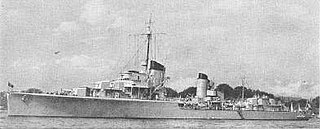 W
WThe Type 1934 destroyers, also known as the Z1 class or Leberecht Maass class after the lead ship, were a group of four destroyers built for the German Navy during the mid-1930s, shortly before the beginning of World War II. The ships were engaged in training for most of the period between their commissioning and the outbreak of war, although they did participate in the occupation of Memel in Lithuania, in early 1939. Z3 Max Schultz collided with and sank a German torpedo boat shortly before the war began on 1 September 1939. All four ships were named after German officers who had been killed in World War I.
 W
WThe German destroyer Z1 Leberecht Maass was the lead ship of her class of four destroyers built for the German Navy during the mid-1930s. Completed in 1937, two years before the start of World War II, the ship served as a flagship and spent most of her time training, although she did participate in the occupation of Memel in early 1939.
 W
WThe German destroyer Z2 Georg Thiele was one of four Type 1934-class destroyers built for the German Navy (Kriegsmarine) during the mid-1930s. She was named after Georg Thiele, a Korvettenkapitän who commanded the Seventh Half Flotilla of torpedo boats. Completed in 1937, two years before the start of World War II, the ship spent most of her time training although she did participate in the occupation of Memel in early 1939.
 W
WThe German destroyer Z4 Richard Beitzen was one of four Type 1934 destroyers built for the German Navy (Kriegsmarine) during the mid-1930s. Completed in 1937, the ship spent most of her time training although she did participate in the occupation of Memel in early 1939. At the beginning of World War II in September 1939, the ship was initially deployed to blockade the Polish coast, but was soon transferred to the Kattegat where she inspected neutral shipping for contraband goods. In late 1939 and early 1940, the ship laid two offensive minefields off the English coast that claimed 17 merchant ships. Z4 Richard Beitzen was in reserve during the Norwegian Campaign of early 1940 and was transferred to France later that year, where she made several attacks on British shipping.
 W
WThe German destroyer Z6 Theodor Riedel was a Type 1934A-class destroyer built for the Kriegsmarine during the mid-1930s. At the beginning of World War II in September 1939, the ship laid defensive minefields to the North Sea. She covered her sister ships over the next few months as they laid offensive minefields in English waters in late 1939–early 1940. She participated in the early stages of the Norwegian Campaign by transporting troops to the Trondheim area in early April 1940 and was transferred to France later that year where the ship covered another minelaying sortie before engine problems caused her to return to Germany in November for repairs. Theodor Riedel was badly damaged when she ran aground three days after her repairs were completed and was out of action until May 1942.
 W
WZ7 Hermann Schoemann was a Type 1934A-class destroyer built for Nazi Germany's Kriegsmarine in the mid-1930s. The ship was plagued by machinery problems for most of her life and was under repair when World War 2 began in September 1939. She covered her sister ships over the next few months as they laid offensive minefields in English waters in late 1939–early 1940. Hermann Schoemann played a minor role in the Norwegian Campaign as engine problems limited her availability throughout 1940 and for most of 1941.
 W
WZ9 Wolfgang Zenker was a Type 1934A-class destroyer built for Nazi Germany's Kriegsmarine in the mid-1930s. Several days after the start of World War II, she unsuccessfully attacked, together with another destroyer, Polish ships anchored at the naval base on the Hel Peninsula. In early 1940 the ship made two successful minelaying sorties off the English coast that claimed six merchant ships. Wolfgang Zenker participated in the early stages of the Norwegian Campaign by transporting troops to the Narvik area in early April 1940. The ship fought in both naval Battles of Narvik several days later and had to be scuttled after she exhausted her ammunition.
 W
WZ10 Hans Lody was a Type 1934A-class destroyer built for Nazi Germany's Kriegsmarine in the mid-1930s. At the beginning of World War II on 1 September 1939, the ship was initially deployed to blockade the Polish coast, but she was quickly transferred to the North Sea to lay defensive minefields. In late 1939 the ship laid multiple offensive minefields off the English coast that claimed nine merchant ships and she crippled a British destroyer during one of these missions.
 W
WZ16 Friedrich Eckoldt was a Type 1934A-class destroyer built for Nazi Germany's Kriegsmarine in the late 1930s. It was named after Kapitänleutnant Friedrich Eckoldt (1887–1916), the commander of torpedo boat V 48, who was killed when his boat was sunk during the Battle of Jutland on 31 May 1916.